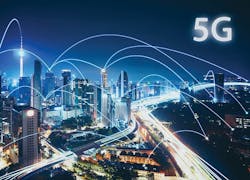March Editorial: 5G infrastructure providers positioned to win big
So far, the vast majority of media coverage on the topic of 5G has been about its potential—all the amazing things 5G speed will enable technology to do. Its new-age applications stretch from traffic lights, to autonomous vehicles and car-to-car communication, to surgical robots—all enhanced through connectivity based around virtually zero latency.
But now, it appears 5G is finally being put into practice. We’ve seen that Verizon has already started rolling out 5G network service in limited capacity this past fall. And what is it that enabled Verizon to be the “First to 5G” and base a marketing campaign around that phrase? Infrastructure.
In October 2018, just after Verizon first announced its initial 5G rollout, the company shared that it had been establishing a 5G network infrastructure for “the past few years.” That foundation included four critical elements: Dark fiber, spectrum, densification, and a software-defined network.
In the February print and digital issues of Evaluation Engineering, Cyient Europe’s Faisal Usmani discussed how 5G networks will be powered by small cells—condensed base posts set up every few hundred feet. Those cells utilize millimeter-wave spectrum, which lack the signal range used by LTE services. While that’s a drawback, the 5G cells’ small size allows them to be installed in greater density, and relatively simple to affix to objects such as light poles, billboards, and buildings in a discrete manner.
“In testing conducted earlier this year on Verizon’s 5G TF network in Houston, Signals Research Group found that millimeter wave signals were more robust than expected and provided high speeds—although not gigabit speeds—at distances of several thousand feet from a node,” reported RCR Wireless News last October.
This small-cell infrastructure will be the key to 5G and all the things it will enable. This means that those companies providing the infrastructure are positioned very well to capitalize over these next few years—perhaps even better than the network providers they are servicing.
Take a look at Crown Castle International: a cell tower real estate investment trust that rents capacity to top wireless carriers, along with the fiber that connects those sites to the networks. Forbes reported on Jan. 27 that Crown Castle has been building and acquiring small-cell infrastructure at a rapid pace, having invested $13 billion across key U.S. markets. The report noted that such small cells support multiple carriers and are upgradable—set up for sustained competitive advantages as 5G rolls out.
Crown Castle’s 2018 financials were superb: First quarter sales of $1.153 billion jumped 35% year-over-year (YoY) and total profit was $114 million; Q2 sales also soared 35% YoY and profit was $180 million; Q3 sales grew another 33% YoY and profit was $164 million; and Q4 sales of $1.209 billion increased 15%, with profit of $213 million.
“We are excited about the opportunity we see to leverage the unmatched portfolio of more than 40,000 towers and 65,000 route miles of dense, high capacity fiber that we have built and acquired over the past two decades in the top U.S. markets where we see the greatest long-term demand,” Crown Castle CEO Jay Brown said in the company’s Q4 earnings press release. “We continue to believe our ability to offer towers, small cells and fiber solutions, which are all integral components of communications networks and are shared among multiple tenants, provides us the best opportunity to generate significant growth while delivering high returns for our shareholders.”
“Ultra-fast, wireless networks are going to change what is possible,” the Forbes report stated. “Investors should seize the opportunity to buy the infrastructure plays now.”
About the Author



